Sony III: hidden features
[smartpay_product id=”10″]
Introduction
The Sony RX100 III is without a doubt the best pocket camera currently available. Compared to its predecessor, Sony now uses a faster f/1.8 – f/2.8 variable aperture 24-70mm fixed lens and the latest Bionz X processor. There are some significant changes in the video department too, and we’ll look at those later in this guide. Make sure you are running firmware version 2.0, released in 2017.
Are you looking for a guide for other RX100 cameras?
The original Sony RX100. You can find them here.
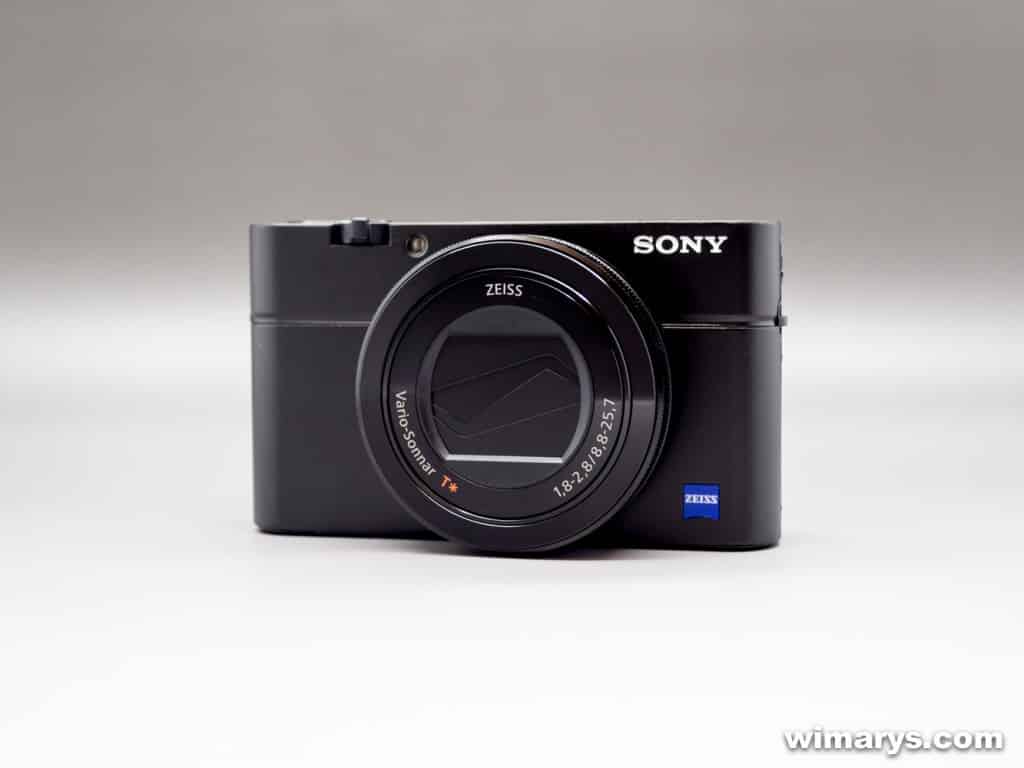
For anyone new to the Sony camera range, there are some Sony RX100 III hidden features that are worth discovering. Read on to find nuùmerous hidden tips and trick in the menus.
Diving into the Sony RX100 III MENU system
When you switch on your camera, you’ll be asked to enter a date, time and timezone. This setting is necessary, as all images captured will have a timestamp, making it easy to find your favorite pictures in the future.
After this is setup, press the MENU button. You’ll see a range of icons and pages.
We’ll start at page 1 of the camera Icon (camera settings)
(MENU → Camera Settings → page 1)
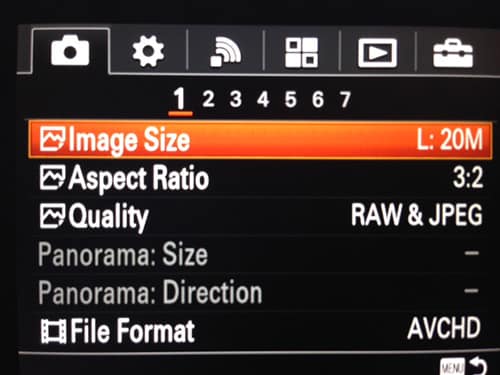
Image size:
The larger the image size, the more detail will be reproduced when the image is printed on large-format paper. The smaller the image size, the more images can be recorded.
Image size when the aspect ratio is 3:2:
- L: 20 megapixels
- M: 10 megapixels
- S: 5 megapixels
Image size when Aspect Ratio is 16:9
- L: 17 megapixels
- M: 7,5 megapixels
- S: 4,2 megapixels
Please note that when Quality is set to RAW or RAW & JPEG, the image size for RAW images is automatically set to L for optimal quality.
If SD card space is an issue, you can set it to Small.
Aspect ratio:
You can choose 3:2 (which uses the full sensor surface) or 16:9 (crop but a more broad view). Leave as is at 3:2, you can always crop your pictures later.
Quality:
Do you edit your pictures on your desktop? If so, set to RAW or RAW+jpeg. A RAW file saves all information the camera pixels register during shooting and will make for better quality images if you want to edit in something like Adobe Lightroom.
A RAW file saves all information the camera pixels register during shooting and will make for better quality images if you want to edit in something like Adobe Lightroom.
A jpeg is a compressed image (available in FINE (larger) and STANDARD (smaller, less quality) which takes up less space on your SD card but is less suited for editing afterward. Jpeg images will also have in-camera noise reduction applied, something you might or might not want to take care of yourself later, depending on your use.
Jpeg images will also have in-camera noise reduction applied, something you might or might not want to take care of yourself later, depending on your use.
Panorama size
(Only available when in panorama shooting mode) Size is selectable between standard and wide. Wide means your picture will cover a larger area. Set it to standard, having to scan an even broader area when making panoramas will take some experience with the camera to do efficiently.
Size is selectable between standard and wide. Wide means your picture will cover a larger area. Set it to standard, having to scan an even broader area when making panoramas will take some experience with the camera to do efficiently.
Set it to standard, having to scan an even broader area when making panoramas will take some experience with the camera to do efficiently.
Panorama direction
A panorama picture (only available in jpeg) is a composite of several images stitched together. When in this mode, you’ll see an arrow that guides you in what direction and speed you should pan the camera to take the sequential images that will be stitched together. You can choose the path in this menu (either, up, down, left or right).
You can make panoramas while scanning your camera up-down or left-right.So what is this all about? This might sound confusing at first, but this comes down to how you hold the Sony RX100 III when shooting panoramas: either in portrait or landscape orientation.
File format
Selects the movie file format.
- XAVC S: Records 60p/50p/30p/25p/24p* /120p/100p movies in XAVC S format. This file format is suitable for high bit rates. Audio: LPCM
- AVCHD (default setting): Records 60i/50i/60p/50p/24p/25p movies in AVCHD format. This file format is suitable for high-definition TV. Audio: Dolby Digital
- MP4: Records mp4 (AVC) movies. This format is suitable for WEB uploads, e-mail attachments, etc. Audio: AAC
Note that when recording XAVC S format movies, you should use the following memory cards:
- SDXC memory card (64 GB or more and Class 10 or faster)
- SDXC memory card (64 GB or more and UHS-I-compatible)
- Memory Stick XC-HG Duo media
(MENU → Camera Settings → page 2)
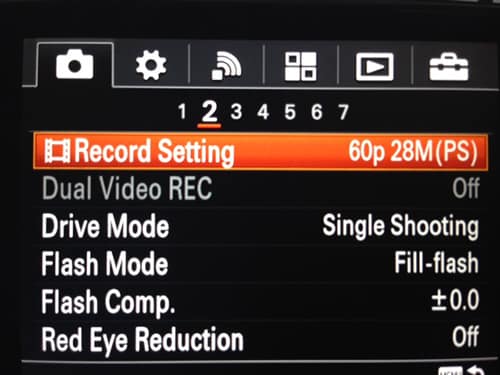
Record setting
Also for video functionality only. You can choose the quality of recorded video here. You can change the image size, frame rate, and image quality for movie recording. The higher the bitrate, the higher the image quality. If you’re not familiar with this, leave as is.
When File Format is set to XAVC S:
- This records high-definition movies by converting them to MP4 file format using the MPEG-4 AVC/H.264 codec.
When File Format is set to AVCHD:
- 60i/50i: Movies are recorded at approximately 60 frames/sec (for 1080 60i-compatible devices) or 50 fields/sec (for 1080 50i-compatible devices). Also in interlaced mode, with Dolby Digital audio, in AVCHD format.
- 24p/25p: Movies are recorded at approximately 24 frames/sec (for 1080 60i-compatible devices) or 25 frames/sec (for 1080 50i-compatible devices). Also in progressive mode, with Dolby Digital audio, in AVCHD format.
- 60p/50p: Movies are recorded at approximately 60 frames/sec (for 1080 60i-compatible devices) or 50 frames/sec (for 1080 50i-compatible devices). Also in progressive mode, with Dolby Digital audio, in AVCHD format.
When File Format is set to MP4:
- Movies shot are recorded in MPEG-4 format, at approximately 30 frames/sec (for 1080 60icompatible devices) or about 25 frames/sec (for 1080 50i-compatible devices), in progressive mode, with AAC audio, mp4 format.
Menu items details:
When File Format is set to XAVC S:
- 60p 50M*/50p 50M** (default setting): Records high image quality movies at 1920 × 1080 (60p/50p). Bit-rate: Approx. 50 Mbps (Avg.)
- 30p 50M/25p 50M**: Records high image quality movies at 1920 × 1080 (30p/25p). Bit-rate: Approx. 50 Mbps (Avg.)
- 24p 50M (Only for 1080 60i compatible models): Records high image quality movies at 1920 × 1080 (24p). This produces a cinema-like atmosphere. Bit-rate: Approx. 50 Mbps (Avg.)
When File Format is set to AVCHD:
- 60i 24M(FX)*: 50i 24M(FX)**: Records high image quality movies of 1920 × 1080 (60i/50i). Bit-rate: Approx. 24 Mbps (Max.)
- 60i 17M(FH) (default setting)*: 50i 17M(FH) (default setting)**: Records standard image quality movies of 1920 × 1080 (60i/50i). Bit-rate: Approx. 17 Mbps (Avg.)
- 60p 28M(PS)*:
- 50p 28M(PS)**: Records the highest image quality movies of 1920 × 1080 (60p/50p). Bit-rate: Approx. 28 Mbps (Max.)
- 24p 24M(FX)*: 25p 24M(FX)**: Records high image quality movies of 1920 × 1080 (24p/25p). This produces a cinema-like atmosphere. Bit-rate: Approx. 24 Mbps (Max.)
- 24p 17M(FH)*: 25p 17M(FH)**: Records standard image quality movies of 1920 × 1080 (24p/25p). This produces a cinemalike atmosphere. Bit-rate: Approx. 17 Mbps (Avg.)
When [ File Format] is set to MP4:
- 1440×1080 12M (default setting): Records movies of 1440 × 1080. Bit-rate: Approx. 12 Mbps (Avg.)
- VGA 3M: Records movies of VGA size. Bit-rate: Approx. 3 Mbps (Avg.) *
- Notes:* 1080 60i (NTSC) compatible device, ** 1080 50i (PAL) compatible device
General notes:
- 60p/50p movies can be played back only on compatible devices.
- Movies recorded with the [60p 28M(PS)]/[50p 28M(PS)]/[60i 24M(FX)]/[50i 24M(FX)]/ [24p 24M(FX)] /[25p 24M(FX)] setting in [ Record Setting] are converted by PlayMemories Home in order to create an AVCHD recording disc. This conversion can take a long time. Also, you cannot create a disc in the original image quality. If you want to keep the original image quality, store your movies on a Blu-ray Disc.
- To play back 24p/25p movies on a TV, the TV must be compatible with the 24p/25p formats. If the TV is not compatible with the 24p/25p format, 24p/25p movies will be output as 60i/50i movies.
- You cannot create discs with movies recorded with [XAVC S] or [MP4] recording settings using PlayMemories Home.
Drive Mode
You can set the drive mode, such as continuous or self-timer shooting.
- Single Shooting (default setting): Shoots one still image. Normal shooting mode.
- Cont. Shooting: Shoots images continuously while you press and hold down the shutter button. Hi: takes about six images per second, Lo about 3
- Self-timer: Shoots an image after 10 or 2 seconds. (selectable in sub menu) You can change the angle of the LCD screen and shoot images while monitoring the image on the screen.
- Self-timer(Cont): Shoots a specified number of images continuously after 10 seconds or 2 seconds (selectable in the sub menu).
- Cont. Bracket: Shoots images while holding the shutter button down, each with different degrees of brightness. (from 3 to 5 images with between .3 and 3 EV difference, selectable in the sub menu.) For processing as HDR on your PC.
- Single Bracket: Shoots a specified number of images, one by one, each with a different degree of brightness. (from 3 to 5 images with between .3 and 3 EV difference, selectable in the sub menu) For processing as HDR on your PC.
- WB bracket: Shoots a total of three images, each with a different color tone according to the selected settings for white balance, color temperature, and the color filter. (3 images with either LO small changes or Hi large changes)
- DRO Bracket: Shoots a total of three images, each at a different degree of D-Range Optimizer.
Dual Video Rec
Allows you to simultaneously record an XAVC S movie and an MP4 movie, or an AVCHD movie and an MP4 movie.
Flash Mode
Flash off;
Turns the flash off, even when the flash unit is popped up.
Autoflash:
The flash works in dark environments or when shooting towards a bright light.
Fill-flash:
The flash works every time you trigger the shutter.
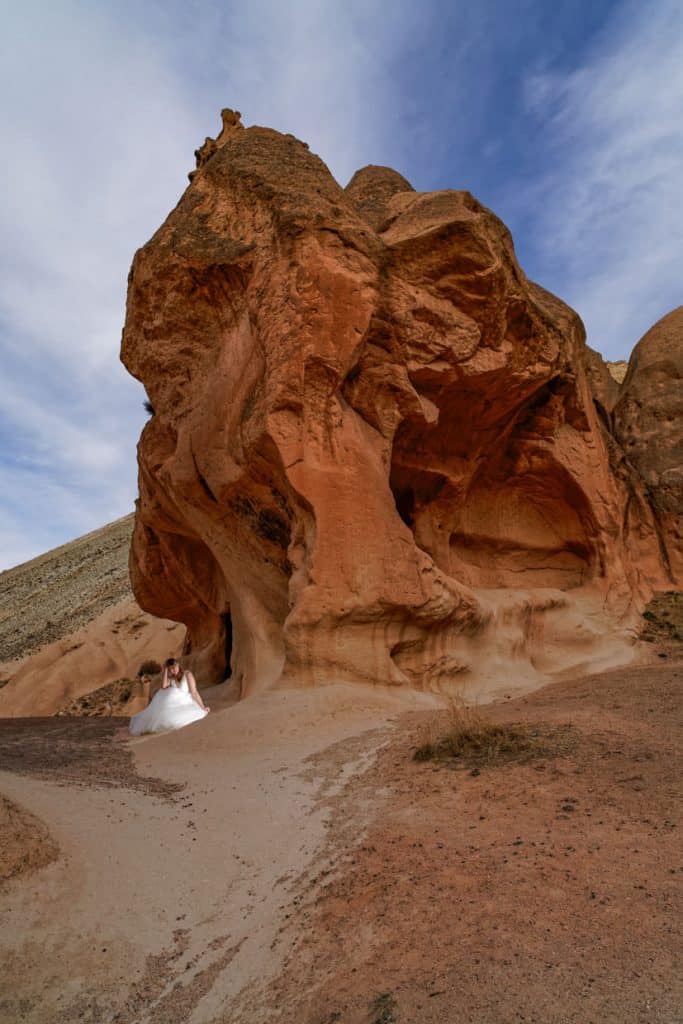
Slow sync:
Tells the camera to use a longer shutter speed along with a flash, and thus is better for night shots. In manual and shutter priority modes, there is no difference in flash power. But when using aperture priority, program, or auto, choosing slow sync tells the camera to use a longer shutter speed than it would ordinarily pick.What the slow sync flash mode actual does is first fire the flash for the subject exposure, then allow for a longer shutter speed that will allow for more ambient light to be captured by the sensor.
Rear Sync:
Capturing an image involves two shutter actions: one when the capture starts and on when it stops. Rear Sync tells the flash to fire right before the shutter closes. Moving objects will show a streak where they came from and a sharp image where they were at the end of the exposure. This conveys a sense of speed with moving objects. Rear Sync is a creative technique, if you’d like to know more about this type of photography, I’d suggest doing a Google search on ‘Rear Sync Flash Photography.’
Flash compensation:
Especially when using Slow Sync or Rear Sync Flash modes, you might have to lower the power of the Flash to get a decently exposed image.
Red Eye Reduction:
This anti-Red Eye setting quickly fires the flash before your image capture starts, reducing the red-eye effect often seen when using a flash
(MENU → Camera Settings → page 3)
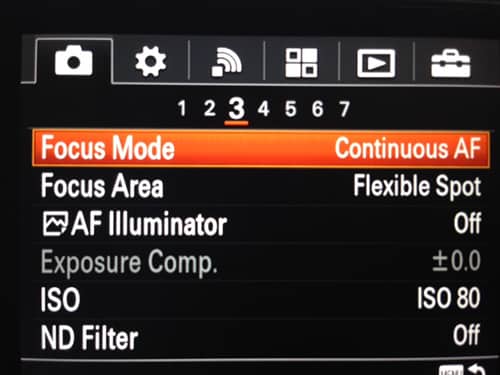
Focus Mode
Here, you can select how the autofocus engine will behave when you half-press the shutter button. This functionality is partly dependent on what focus area you select (see next)
AF-S:
With a half-press of the shutter button, the camera will focus only once. Suitable for capturing stills.
AF-C:
The camera will continuously focus on any movement when you half-press the shutter button.
DMF:
The RX100 Mark 3 focuses on your subject and allows you to fine tune your focus area further using the manual focus ring on the lens.
MF:
No autofocus is used, and you focus manually using the focus ring on the lens.
Focus area
You might think it is best to leave it on the factory ‘wide’ setting (as this uses all AF points), but for certain scenes, it is often better to use a zone or flexible spot to get it to focus on what you want.
Wide:
Wide focus area uses all focus points on the sensor. Ideal for action scenes where there is a lot of movement going on in your frame.
Center:
Focusses on whatever is centered in your images. A fail-proof way of getting the camera to focus on what you want. If you have any problems using the autofocus and are in a situation where you don’t want to miss any shots, revert to Center and just make sure you have your subject centered.
Flexible spot:
Flexible spot area selects a spot anywhere on the screen where the camera should focus. (similar to Center spot, except not.. in the center) You can set it to small, medium or large. If you want to use this focus area, set it to medium or large, as the camera will struggle to find focus when set to small (except perhaps for close-up portraits where you’d want to focus on the iris of the eye)
Lock-on AF:
When the shutter button is pressed and held halfway down, the product tracks the subject within the selected autofocus area. Point the cursor to [Lock-on AF] on the [Focus Area] setting screen, then select the desired tracking start area using the left/right sides of the control wheel. You can move the tracking start area to the desired point by designating the area to be the flexible spot. On the Flexible Spot shooting screen, you can change the size of the AF range finder frame by rotating the control wheel.
AF Illuminator:
The AF illuminator is a little red light allowing the camera to focus more easily when the shutter button is pressed halfway. It automatically is switched off when you fully press the shutter. Leave it on.
Exposure Comp
(Also available in the Quick Menu, accessed by pressing the FN button):
If you find that your image is overexposed (for instance when you are shooting at large apertures for a shallow depth-of-field in bright daylight), you can tweak the exposure compensation here in a plus or minus 5 (exact EV dependent on next step) range.
ISO
You can select at which ISO value you’d like to capture your image or change the AutoISO range
I have this range set between 100-1600 as this range is virtually noise free, and I don’t like the ISO performance above 3200. If you’re a jpeg shooter (and use built-in Noise Reduction), you might think of using a higher top value (factory setting goes up to 12800).
ND filter
From the Mark 3 onwards, the Sony comes with a built-in 3 stop ND filter. If you use an ND filter, the amount of light entering the camera is reduced. You can slow down the shutter speed and decrease the aperture value for a better exposure.
- Auto (default setting): Automatically turns on the ND filter based on the shooting mode and brightness.
- On: Always uses built-in ND Filter.
- Off: Disables the ND Filter function.
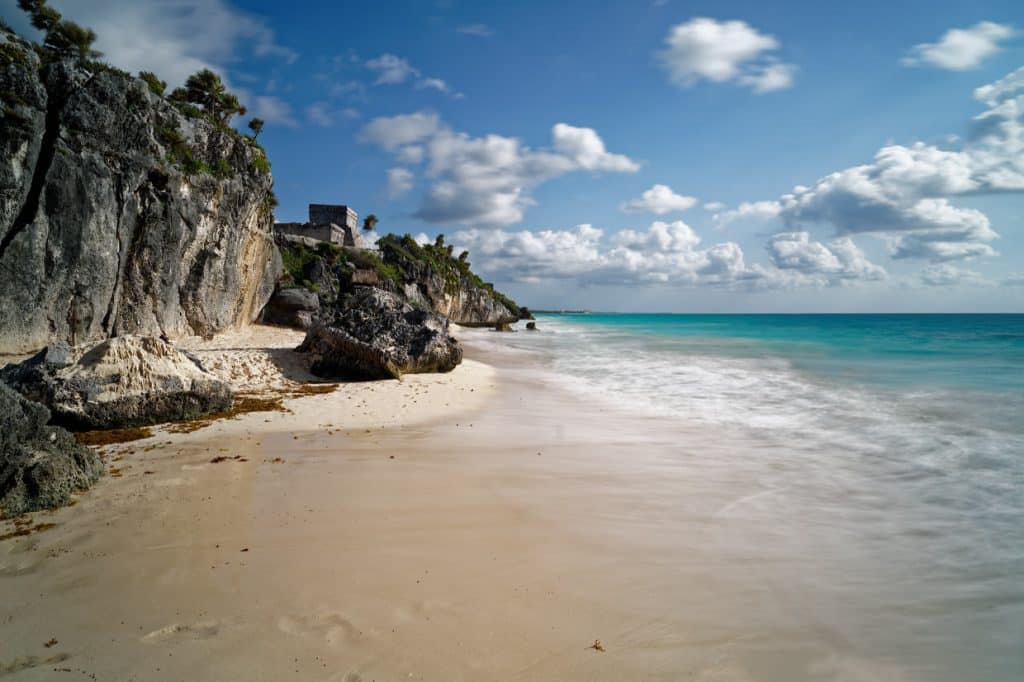
(MENU → Camera Settings → page 4)
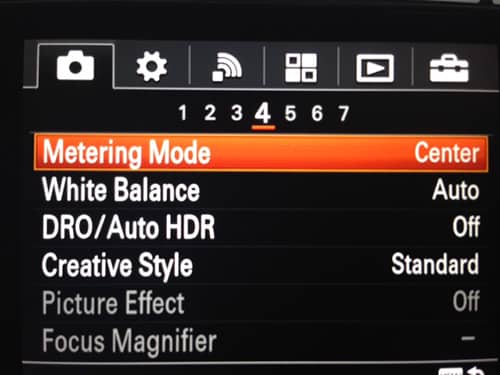
Metering Mode
Metering mode refers to the way the camera reads the light and sets the exposure.
In multi, it considers the whole frame and sets exposure according to internal algorithms programmed in camera.
In spot or center, the camera only considers what is in that spot or the center (per example, if your subject is completely black, the camera will try to compensate by overexposing the image).
White Balance
You can either:
- Auto (default setting): The product automatically detects the light source and adjusts the color tones.
- Daylight: The color tones are adjusted for the daylight. Shade: The color tones are adjusted for shadiness.
- Cloudy: The color temperature is adjusted for a cloudy sky. Incandescent: The color temperature is adjusted for places under an incandescent lamp, or under bright lightings, such as in a photo studio.
- Fluor.: Warm White: The color temperature is adjusted for warm white fluorescent lighting.
- Fluor.: Cool White: The color temperature is adjusted for white fluorescent lighting.
- Fluor.: Day White: The color temperature is adjusted for neutral white fluorescent lighting.
- Fluor.: Daylight: The color temperature is adjusted for daylight fluorescent lighting.
- Flash: The color temperature is adjusted for a flash.
- Underwater Auto: The color temperature is adjusted for underwater shooting.
- C.Temp./Filter: Adjusts the color tones depending on the light source. Achieves the effect of CC (Color Compensation) filters for photography.
- Custom: Uses the white balance setting saved in [Custom Setup].
- Custom Setup: Memorizes the basic white color under the light conditions for the shooting environment.
- Underwater Auto: new feature from the 2017 firmware version 2.0 update. Similar ro the regular Auto White balance, the camera will automatically adjust white balance when used underwater in an underwater housing like the Sony MPK-URX100A.
DRO/Auto HDR
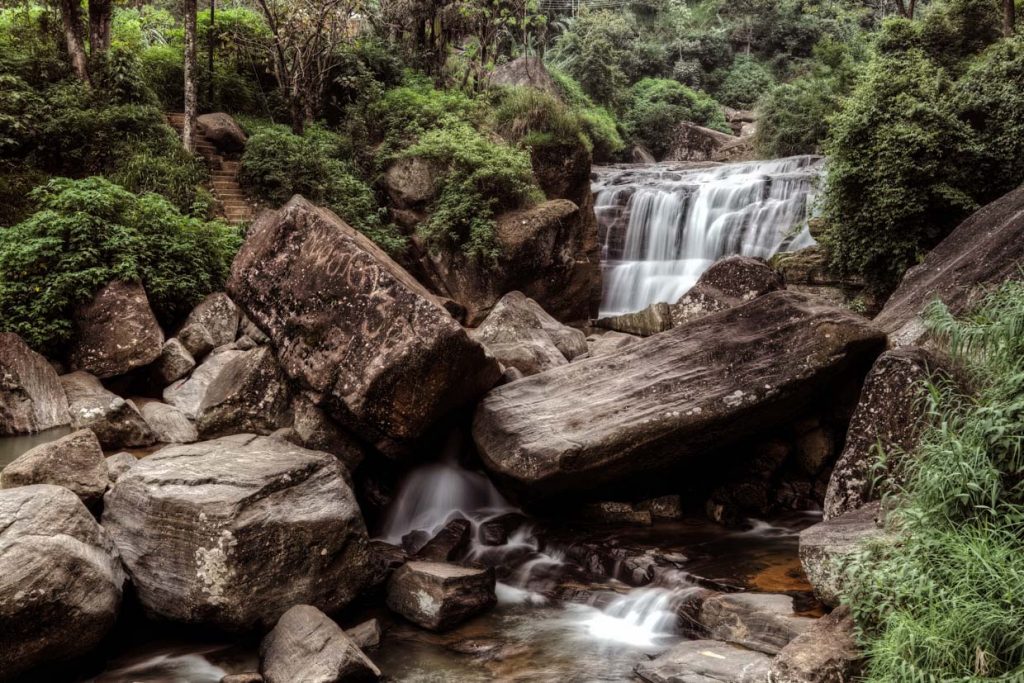
DRO:
This stands for Dynamic range optimize and analyses the contrast of your scene in real-time. It produces an image with optimal brightness and recovered shadow detail. You can use this function even while the subject is moving or during the continuous shooting.
- D-Range Optimizer: Auto (default setting): Corrects the brightness automatically.
- D-Range Optimizer: Lv1 ― D-Range Optimizer: Lv5: Optimizes the gradation of a recorded image for each divided area. Select the optimization level from Lv1 (weak) to Lv5 (strong)
Auto HDR:
(not available for RAW captures) this feature Shoots three images with different exposures and then overlays the bright area of the underexposed image and the dark area of the over exposed image to create a picture with an extended range from highlight to shadow.
The highlight detail in auto HDR is better than that in DRO and with reduced noise. The shutter is released three times, so using this function for moving subjects is not recommended.
- Auto HDR: Exposure Diff. Auto (default setting): Corrects the exposure difference automatically. Auto HDR: Exposure Diff. 1.0EV ―
- Auto HDR: Exposure Diff. 6.0EV: Sets the exposure difference, based on the contrast of the subject. Select the optimal level between 1.0 EV (weak) and 6.0 EV (strong). For example, if you set the exposure value to 2.0 EV, three images will be composed of the following exposure levels; −1.0 EV, optimal exposure, and +1.0 EV
Creative Style
This menu setting allows you to select the desired image processing. You can adjust exposure (shutter speed and aperture) as you like with [Creative Style], unlike with [Scene Selection] where the product adjusts the exposure.
- Standard (default setting): For shooting various scenes with rich gradation and beautiful colors.
- Vivid: The saturation and contrast are heightened for shooting striking images of colorful scenes and subjects such as flowers, spring greenery, blue sky, or ocean views.
- Portrait: For shooting the skin color in a soft tone, ideally suited for shooting portraits.
- Landscape: The saturation, contrast, and sharpness are heightened for shooting vivid and crisp scenery. Distant landscapes also stand out more.
- Sunset: For shooting the beautiful red of the setting sun.
- Black & White: For shooting images in black and white monotone.
- Sepia: For shooting images in sepia monotone.
Contrast, Saturation, and Sharpness can be adjusted for each Creative Style item. Select an item to be set by pressing the right/left side of the control wheel, then set the value using the top/bottom side of the control wheel.
- Contrast: The higher the value selected, the more the difference of light and shadow is accentuated, and the bigger the effect on the image.
- Saturation: The higher the value selected, the more vivid the color. When a lower value is selected, the color of the image is restrained and subdued.
- Sharpness: Adjusts the sharpness. The higher the value selected, the more the contours are accentuated, and the lower the value selected, the more the contours are softened.
Picture Effect
Think of this menu as an Instagram app right in your camera, with all kinds of retro filters and effects. These are only available when quality is set to Jpeg (Not in RAW).

- Off (default setting): Disables the Picture Effect function.
- Toy Camera: Creates a soft image with shaded corners and reduced sharpness.
- Pop Color: Creates a vivid look by emphasizing color tones.
- Posterization: Creates a high contrast, abstract look by heavily emphasizing primary colors, or in black and white.
- Retro Photo: Creates the look of an aged photo with sepia color tones and faded contrast.
- Soft High-key: Creates an image with the indicated atmosphere: bright, transparent, ethereal, tender, soft.
- Partial Color: Creates an image which retains a specific color, but converts others to black and white.
- High Contrast Mono.: Creates a high-contrast image in black and white.
- Soft Focus: Creates an image filled with a soft lighting effect.
- HDR Painting: Creates the look of a painting, enhancing the colors and details.
- Rich-tone Mono.: Creates an image in black and white with rich gradation and reproduction of details.
- Miniature: Creates an image which enhances the subject vividly, with the background defocused considerably. This effect may often be found in pictures of miniature models.
- Watercolor: Creates an image with ink bleed and blurring effects as if painted using watercolors.
- Illustration: Creates an illustration-like image by emphasizing the outlines.
Focus Magnifier
When focussing manually or in DMF mode, you can set the camera to magnify a part of the screen so you can check focus. This sub-menu allows you to select the part of the image that will be magnified during shooting.
(MENU → Camera Settings → page 5)
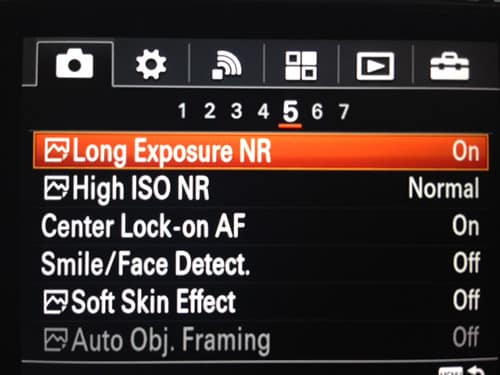
Long exposure NR
Yes, finally it’s here for Sony RX100 users, Long exposure Noise Reduction. This kicks in when you set the shutter speed to 1/3 second or longer. Noise reduction is turned on for the duration that the shutter is open. With the function turned on, the grainy noise typical of long exposures is reduced.
High ISO NR
Here you can select the amount of noise reduction applied to images with high ISO settings (when quality is set to jpeg). As Sony has rather aggressive noise reduction, I would chance it to Low. (if not, you run the risk of getting paint-like, smeared images at higher ISO values)
Center Lock-on AF

This is a very powerful autofocus feature. When turned ON, it allows you to track a subject. In the iAuto mode, you can access this feature (when turned ON and the camera is set to AF) by pressing the Center button of the multi-controller. You’ll see a square on your screen, then center your desired tracking subject and the camera will continue to track it, even when it exits your frame and reappears.
Smile/Face Detect
This is another powerful feature. It can be set to automatically detect on focus on (registered) faces and enable a function called Smile Shutter. When the latter is enabled, the camera will automatically capture an image when a smile is detected. Did I hear you say Selfie? Yes, it’s the ultimate selfie tool, along with the pivoting screen.
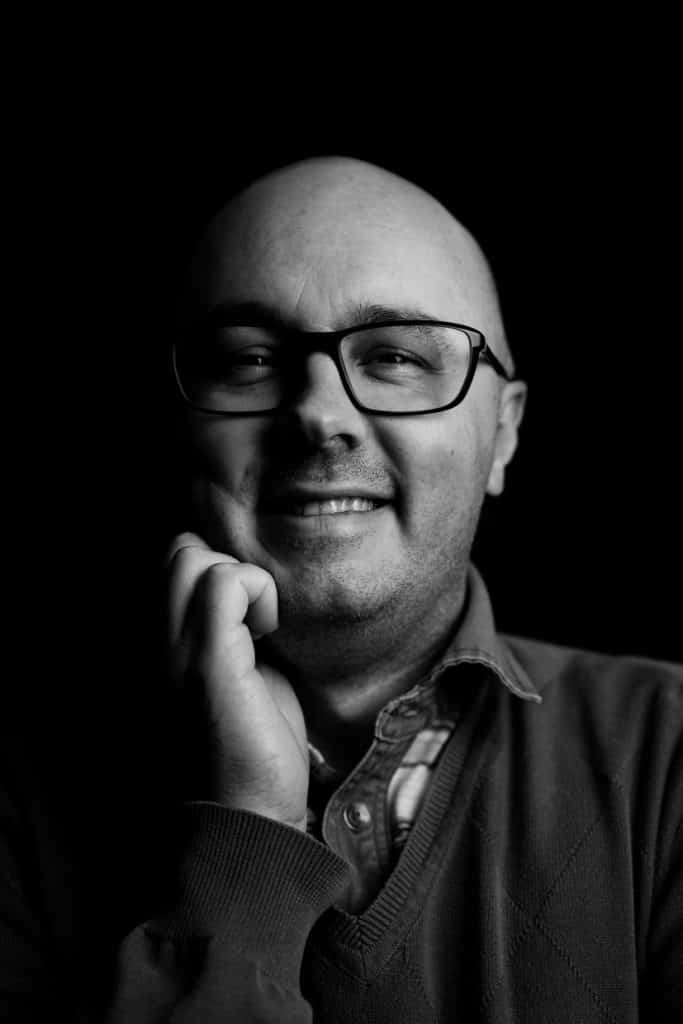
Soft skin effect
Sets the effect used for shooting the skin smoothly in the Face Detection function. I don’t like the results, so on my camera, it is turned off.
Auto Object Framing
When enabled, the Sony RX100 III will automatically crop your captured image to what it deems best. Meaning it will cut the picture for a nicer composition. Only available for Jpegs, though, a nice feature if you don’t want to bother too much with the technical side of photography.
(MENU → Camera Settings → page 6)
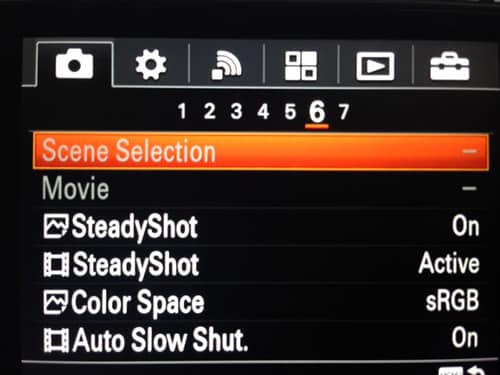
Scene Selection
This allows you to shoot with preset settings according to the scene. To change the scene, simply rotate the control wheel on the shooting screen and select a new scene.
- Portrait: Blurs background and sharpens the subject. Accentuates the skin tones softly.
- Sports Action: Shoots a moving subject at a fast shutter speed so that the subject looks as if it is standing still. The product shoots images continuously while the shutter button is pressed.
- Macro: Shoots close-ups of the subjects, such as flowers, insects, food, or small items.
- Landscape: Shoots the entire range of a scenery in sharp focus with vivid colors.
- Sunset: Shoots the red of the sunset beautifully.
- Night Scene: Shoots night scenes without losing the dark atmosphere.
- Hand-held Twilight: Shoots night scenes with less noise and blur without using a tripod. A burst of shots are taken, and image processing is applied to reduce subject blur, camera shake, and noise.
- Night Portrait: Shoots night scene portraits using the flash. The flash does not pop-up automatically. Pop-up the flash before shooting.
- Anti Motion Blur: Allows you to shoot indoor shots without using the flash and reduces subject blur. The product shoots burst images and combines them to create the image, reducing subject blur and noise.
- Pet: Allows you to shoot images of your pet with the best settings.
- Gourmet: Allows you to shoot food arrangements in delicious and bright colors.
- Fireworks: Allows you to shoot images of fireworks in all their splendor.
- High Sensitivity: Allows you to shoot still images even in dark locations without using the flash, and reduces subject blur. Also allows you to shoot dark movie scenes more brightly
- Movie
Steadyshot (stills)
Sets whether or not to use the SteadyShot (also known as image stabilization) function for photography. Steadyshot allows you to take sharp pictures at longer shutter speeds (say on a cloudy day). It stabilizes your image and is a very powerful feature. Set it to ON, except when shooting on a tripod.
SteadyShot (movies)
Sets SteadyShot when shooting movies.
Here you have three options:
- Intelligent Active: Provides the most powerful SteadyShot effect. I set it to this.
- Active (default setting): Provides a more powerful SteadyShot effect.
- Standard: Reduces camera shake under stable movie shooting conditions.
Color Space
You can choose between Standard and Adobe (extended color range)RGB. If you don’t know what this means, leave it to standard.
Auto Slow Shutter (movie mode)
Sets whether to adjust the shutter speed automatically during video recording in case if the subject is dark/ Set to ON.
(MENU → Camera Settings → page 7)
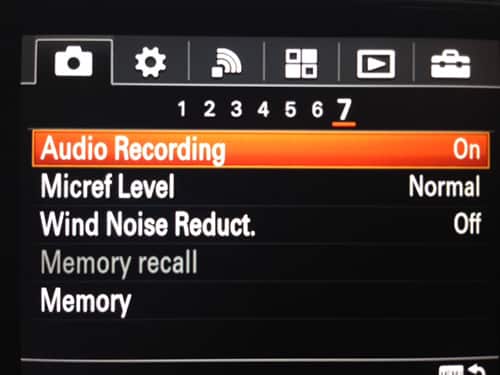
Audio Recording
You can switch off audio recording in movie mode.
Micref Level
You can select the microphone level for movie recording to Normal (for dialogue) or Low (for concerts etc).
Memory Recall
Allows you to shoot an image after recalling often-used modes or camera settings registered in advance.
- Set the mode dial to MR (Memory recall).
- Press the left/right side of the control wheel or turn the control wheel to select the desired number, then press on the center
- You can also recall registered modes or settings by selecting MENU → (Camera Settings) → Memory recall.
Memory
Allows you to register up to 3 often-used modes or product settings in the product. You can recall the settings using just the mode dial.
Items that can be registered:
- Shooting mode
- Aperture (F number)
- Shutter speed
- Camera Settings
- Optical zoom scale
To recall registered settings: Set the mode dial to MR, then press the right/left side of the control wheel or turn the control wheel to select the desired memory number.
To change registered settings: Change the setting to the desired one and re-register the setting to the same mode number.
(MENU → Custom settings (wheel) → page 1)
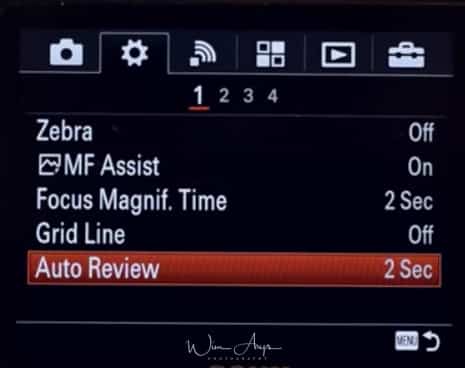
Zebra
The zebra function shows a zebra pattern on the screen while shooting in any area that is in danger of highlight clipping. You can switch this OFF or anywhere in a range between 70 and 100.The Zebra Pattern is a highlight warning indicator that is common in video cameras. It does not control exposure but just warns you that your highlights are blown out. It is not recorded into the resulting image.I have it set halfway at around 75, and it is a very useful indication of correct exposure of the full picture. As I capture in RAW, I am very careful not to have any highlight clipping, to be able to recover highlights in Lightroom possibly entirely.
MF assist
This works in conjunction with the Focus Magnifier on Page 5 of the camera settings. You might remember that you can select the area to magnify there when using manual focus (MF). MF assist will need to be turned on if you want to use this feature.
Focus Magnif Time
You can set how long to hold the magnified area during MF assist. 2 sec, 5 seconds or no limit. 2 seconds is how I have it set up.
Grid Line
Having a grid line on your screen is a helpful aide for the composition of your image.
The human brain is hard-wired to recognize the structure, and most people find a well-composed image more eye-pleasing.
During photography history, rules have been developed on how to compose the different elements best within a scene. Many landscapes you’ll see have the horizon run through the middle of the image for instance, but this is just composition in its simplest form. Many photographers with a thorough understanding of these techniques go far beyond that.
A good starting point is using the in-camera grid to make your brain aware of the possibilities in composition.
The Rules of 3rds, Square and Diag +square are available in the Sony Alpha ILCE-5100.
Auto Review
Select the amount of time the camera displays your image directly after capturing the image. 10, 5 and 2 sec is available, or you can turn this feature OFF if it annoys you.
MENU – Custom Settings – page 2
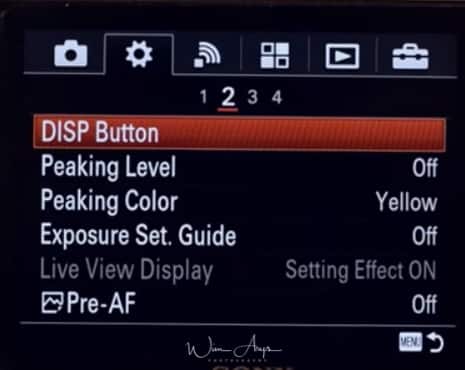
Disp button
Selects the functionality (what is shown) on the screen when you press the DISP button (on the control wheel). You can choose Graphic Display, all info; no dips info and histogram.
Peaking Level
- Peaking Level is a manual focusing aid that works when you have your camera set to MF or DMF.
- You’ll see a type of noise outlining the parts of your image where the focus lies; you can adjust the sensitivity to high, mid or low.
- Which setting is best depends on what lens you use, as with a sharper lens it can be configured to low, while more soft lenses benefit from a medium or high setting to clearly visualize what you’re focusing on.
Peaking Color
You can choose the color of this Peaking between Red, white and yellow. I have it set to red, as this contrasts nicely with most scenes you capture.
Exposure set guide
Sets the guide displayed when exposure settings are changed in the shooting screen. Excellent tool when you’re getting to know the functionality of your new camera. If you’re familiar with Sony’s feature, turn it OFF.
Live view Display
Live view display allows you to see the image you’re going to capture with the settings you have dialed in like aperture and shutter speed. Some users report easier auto-focussing in low-light when it’s turned OFF, and you’d need to turn it off when using external flashes too that can’t be used with Sony’s TTL (through the lens) functionality.
Pre AF
When pre-AF is set to ON, the camera will continuously focus, even without half-pressing the shutter button. This can be draining to the battery, especially when using some lenses like the Zeiss Touit range. Set it to OFF.
Many People prefer to set Pre-AF off. This to prevent the camera from constantly trying to acquire focus without pressing the shutter button. It also saves battery life.
MENU – Custom Settings – page 3
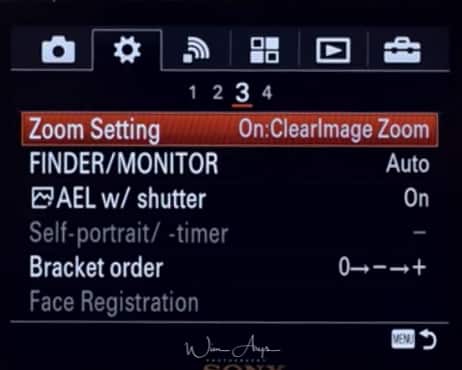
Zoom settings
Set to Optical zoom only (using the optical zoom capabilities of your lens. If you set this to digital zoom, the camera will be basically cropping pixels out.
Finder/Monitor
Sets the method for switching the display between Electronic Viewfinder and the screen.
- Auto (default setting): When you look into the Electronic Viewfinder, the display is switched to the Electronic Viewfinder automatically.
- Viewfinder: Switch between the Electronic Viewfinder display and the screen display by pushing up/down the pop-up finder. When the Electronic Viewfinder is pushed down, the image is displayed only on the screen. When the Electronic Viewfinder is pushed up, the screen is turned off and the image is displayed only in the Electronic Viewfinder.
AEL with shutter
Selects whether to fix exposure automatically when you press the shutter button halfway down. Leave ON.
- Auto (default setting): Fixes the exposure after adjusting the focus automatically when you press the shutter button halfway down when [Focus Mode] is set to [Single-shot AF]. When [Focus Mode] is set to [Automatic AF], and the product determines that the subject is moving, or you shoot burst images, the fixed exposure is canceled.
- On: Fixes the exposure when you press the shutter button halfway down.
- Off: Does not fix the exposure when you press the shutter button halfway down. Use this mode when you want to adjust focus and exposure separately.
Self-portrait timer
You can change the angle of the LCD screen and shoot images while monitoring the image on the screen.
- Tilt the LCD screen 180° upward, and then point the lens at yourself.
- Press the shutter button. The product starts the self-timer shooting after three seconds. Hint If you want to use another Drive Mode than the 3-second self-timer mode, first set [Selfportrait/ -timer] to [Off], then tilt the monitor upward approx. 180 degrees.
- Hint If you want to use another Drive Mode than the 3-second self-timer mode, first set Self-portrait/ -timer to Off, then tilt the monitor upward approx. 180 degrees.
Bracket order
You can set the shooting order for exposure bracketing and white balance bracketing.
Face Registration
This is where you can register faces; it works only when face recognition is set to ON (registered faces). This is an interesting functionality, as you can register faces of your subject (like at a wedding the bride and groom) and the camera will automatically detect these registered faces and give autofocus priority to them. You can register up to 8 faces (by taking a picture of them within this menu) and set a priority order.
Works well, and helps to get the right people in-focus in busy shots.
MENU – Custom Settings – page 4
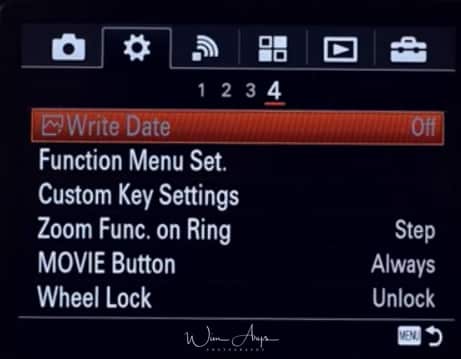
Write Date
Sets whether to record a shooting date on the still image.
Function menu set
You can assign the functions to be called up when you press the Fn (Function) button.
Custom keys setting
Assigning functions to the various keys allows you to speed up operations by pressing the appropriate key when the shooting information screen is displayed.
Zoom Func. on ring
Sets the zoom functions when using the control ring to change zoom scales. The settings for Zoom Func. on Ring are valid only when auto-focusing.
- Standard (default setting): Zooms in/out smoothly when you operate the zoom by turning the control ring.
- Step: Zooms in/out at certain angle steps when you operate the zoom by turning the control ring.
Movie button
Sets whether or not to activate the MOVIE button.
- Always (default setting): Starts movie recording when you press the MOVIE button in any mode.
- Movie Mode Only: Starts movie recording when you press the MOVIE button only if the shooting mode is set to Movie mode.
Wheel lock
You can set whether the wheel will be locked by pressing and holding the Fn (Function) button.
MENU – Wireless functionality – page 1
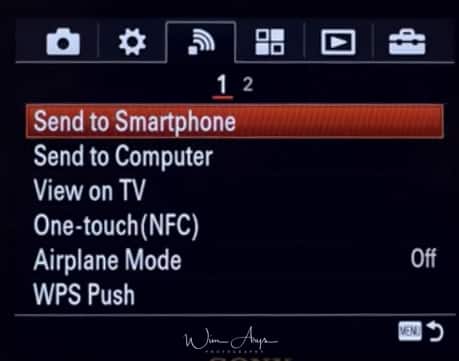
Send To Smartphone
- You can send one or several images directly to your wireless device (phone or tablet) by pressing this button.
- You can either decide to choose which images you want to transfer on the camera or on the wireless device (via the Sony PlayMemories app, available for free in the apple or android store).
- You’ll have to connect the camera via Wifi first (it makes a Wifi access point), using the instruction on the Sony RX100 III screen.
- It works just like connecting to any other access point with your phone or tablet.
- You should do this as quickly as possible, just to get it out of the way.
- When your phone has wirelessly connected to the camera once, and you’ve entered the password, it will remember this, and make it a lot faster to connect later.
Send to Computer
You’ll need to physically connect the computer to the camera using the supplied USB cable, and you can push selected pictures to your Sony PlayMemories desktop software (installed from the CD or downloaded from their website). This can even be set up to continue pushing images after the camera has turned off.
View On TV
If you have a Wifi-enabled TV, you can view images and slideshows directly from your camera through your home wireless network.
One Touch NFC
Enables Quick, one-touch connection (as opposed to first accessing the camera’s wireless network and then navigating to the Playmemories app) with NFC (near-field communication) capable devices.
I have not tried this (as my iPhone does not have NFC) but it looks a lot easier to use.
Airplane Mode
Disables all wireless functionality, just like airplane mode does on your phone.
WPS Push
If your access point has the WPS button, you can register the access point to the camera easily by pushing the WPS button.
MENU – Wireless functionality – page 2
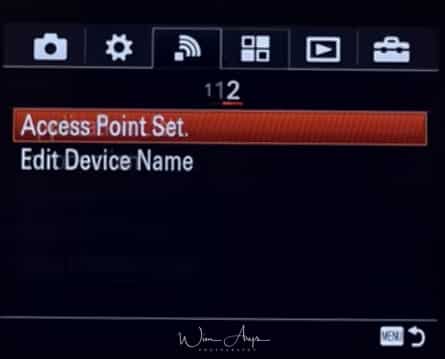
Access Point Set
Here you can setup an access point for your camera to the internet.
It enables the Sony RX100 II to install PlayMemories apps from the internet directly. Works just like setting an access point (WiFi connection) on your phone.
Edit Device name
If you wish, you can change the name of the Device Access point perhaps to make it easier to identify which A6000 is yours in certain situations.
MENU – Playmemories settings- page 1
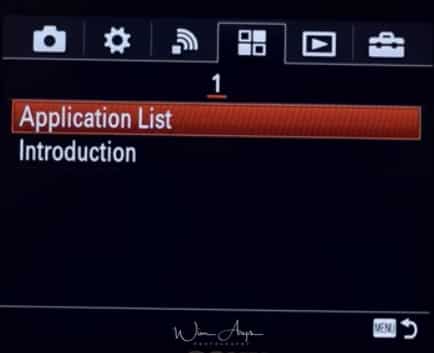
Application List
You’ll find The Smart remote control camera app (wich allows you to use your phone as a remote control via PlayMemories phone app for iPhone and Android) and the Playmemories Camera app here.
You can access your online PlayMemories account here, or create an account (once you’ve set up your camera connection with your Wifi network).
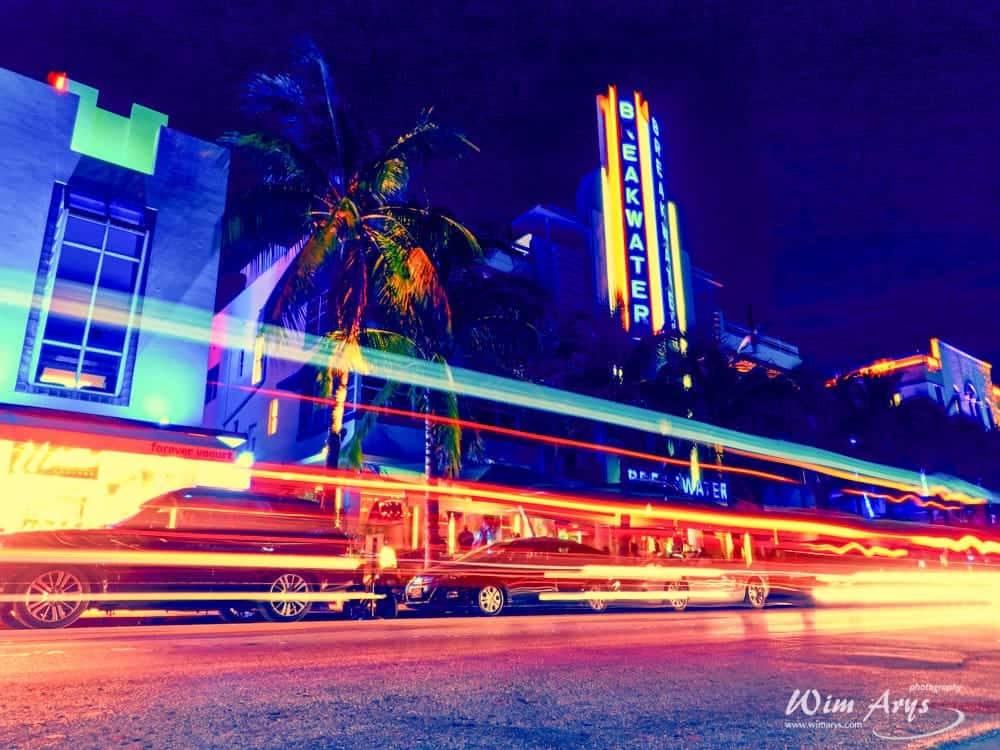
You’ll also be able to download new apps available for purchase in the Sony Playmemories online app store like the Time-lapse and smooth reflection app.
If you do not want to connect your camera to the internet, you can always install new apps (and updates) if you connect the camera to your Mac or PC with the supplied USB cable, using the Sony PlayMemories desktop application.
MENU – playback options – page 1
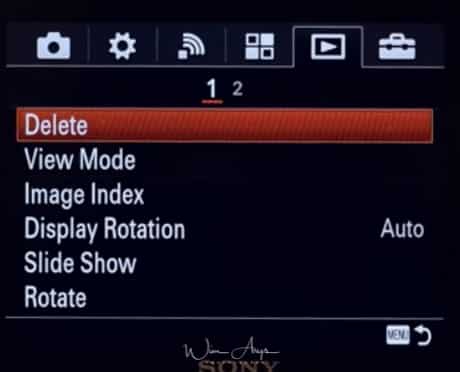
Delete
Delete on or multiple images stored on your SD card.
View Mode
select how the camera will arrange captured images in the viewing browser.
Image Index
Select whether you want the image browser to display 12 (larger) or 30 (smaller) images per page.
Display rotation
Select whether you want the camera to automatically rotate images when you rotate the camera or not.
Slide Show
Select whether you want the camera to repeat slideshows when all pictures are viewed or not, and choose the interval between slides.
Rotate
Change the orientation of images in-camera.
MENU – playback options – page 2
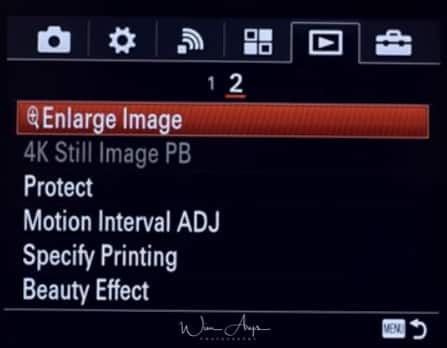
Enlarge
Select an image and enlarge a portion of that image. Useful for checking details and focus.
4K Still Image PB
Outputs still images in 4K resolution to an HDMI-connected TV that supports 4K.
Protect
Protect images (selectable or per date) from accidentally being erased.
Motion Interval ADJ
Change the interval of the image tracking of the subject’s motion in high-speed, like a stroboscopic image.
Specify Printing
Specify Printing is a feature that allows images to be marked for printing later. Registered images are displayed with the DPOF mark. (DPOF stands for Digital Print Order Format)
Beauty Effect
Allows you to apply the Beauty Effect to retouch the still image of a person and make it look better, for example, by retouching it for smoother skin, larger eyes, and whiter teeth. You can set the effects from level 1 to level 5. An image on which the Beauty Effect is used is saved as a new file. The original image is retained as it is.
- Skin Toning: Adjusts the skin color as you like.
- Skin Smoothing: Removes age spots and wrinkles from the skin.
- Shine Removal: Reduces the look of oily skin. Adjusts the skin color as you like.
- Eye Widening: Enlarges the eyes of the subject.
- Teeth Whitening: Whiten the teeth of the subject.
To use two or more effects with Beauty Effect one after another, first apply an effect to the image, then select another effect using.
MENU – Setup – page 1
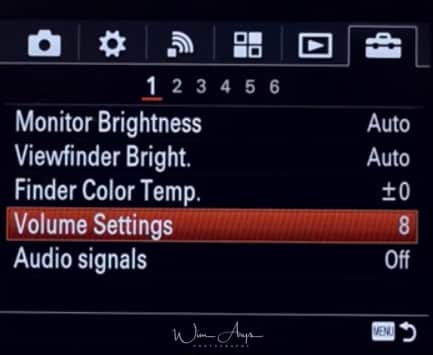
Monitor Brightness
Manually set the Monitor brightness (recommended leave to zero) or change to a brighter setting for Sunny Weather.
Viewfinder Bright.
When using an electronic viewfinder, you can adjust the brightness of the electronic viewfinder according to the surrounding environment. Leave it on Auto.
Finder Color Temp.
Adjusts the color temperature (-2 +2) of the electronic viewfinder.
Volume settings
Change the playback volume for recorded video or demos.
Audio Signals
You can turn off audio signals like the beep when te camera achieves focus. Useful if you want a more stealthy operation (although you’ll still hear the second curtain shutter).
MENU – Setup – page 2
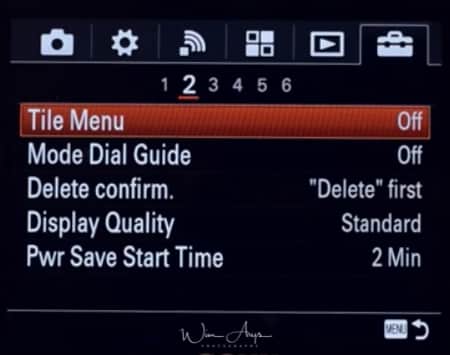
Title Menu
choose between tiles or a tiled front page when accessing the MENU or a direct tab style menu layout
Mode Dial Guide
You can display the description of a shooting mode when you turn the mode dial and change the settings available for that shooting mode. Handy when you are learning how to use the RX100 II.
Delete confirm
You can set whether Delete or Cancel is selected as the default setting on the delete confirmation screen.
Display Quality
You can change the display quality. Set to standard to preserve battery life.
- High: Displays in high quality.
- Standard: Displays in standard quality.
Pwr Save Start time
Selects the time it takes for the camera to go into sleep mode if you don’t use it.
MENU – Setup – page 3
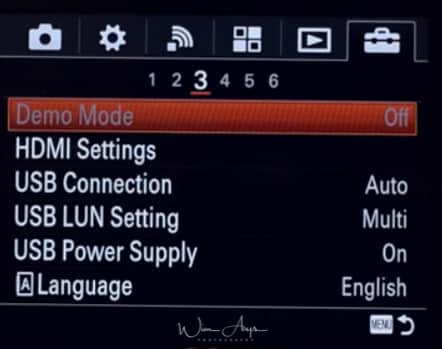
Demo Mode
Demo mode is only used in retail stores for demonstration purposes.
HDMI settings
You can find all HDMI connection settings here:
- HDMI Resolution: When you connect the product to a High Definition TV with HDMI terminals using an HDMI cable, you can select HDMI Resolution to output images to the TV. Auto, 1080p and 1080i are available.
- CTRL FOR HDMI: When connecting the Sony RX100 III to a “BRAVIA” Sync-compatible TV using an HDMI cable, you can operate this product by aiming the TV remote control at the TV. Turn it ON if you want to use it.
- HDMI Info. Display: Selects whether to display the shooting information when this product and the TV are connected using an HDMI cable.
USB connection
Selects what will happen when you connect your camera to your PC or MAC.
- Auto (default setting): Establishes a Mass Storage or MTP connection automatically, depending on the computer or other USB devices to be connected. Windows 7 or Windows 8 computers are connected in MTP, and their unique functions are enabled for use.
- Mass Storage: Establishes a Mass Storage connection between this product, a computer, and other USB devices.
- MTP: Establishes an MTP connection between this product, a computer, and other USB devices. Windows 7 or Windows 8 computers are connected in MTP, and their unique functions are enabled for use.
USB LUN Setting
Improves compatibility with external devices by limiting the functions of the USB connection.
Older devices that are not able to connect to the camera might work when set to single. Otherwise, use Multi.
Language
Set your preferred language. The advantage of setting it to Eglish is that you’ll find much more information online when you need any troubleshooting.
MENU – Setup – page 4
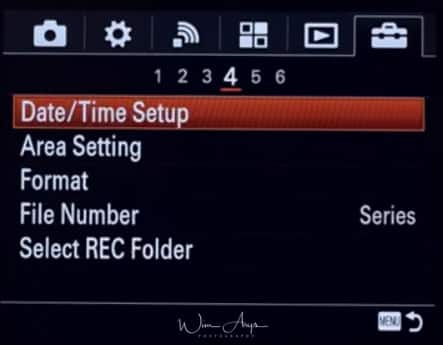
Date Time Setup
Change date, time, date format and Daylight savings time
Area setting
Select your region, or change region when abroad, the camera will automatically change time and date for you.
Format
Format your SD card before use; this will erase any images still on the memory card.
File Number
Number your files according to number of shots or reset it to start from 1
Select REC folder
Selects where the camera will store newly captured images
MENU – Setup – page 5
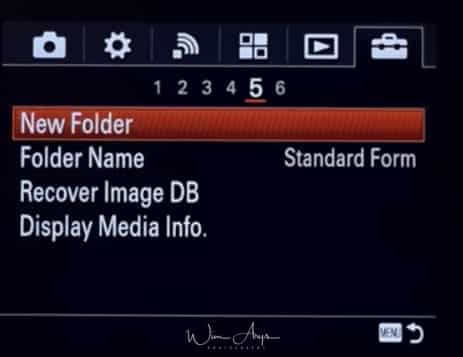
New Folder
Make a new folder for easily organizing events and locations
Folder name
Choose whether to have folder names in standard form (DSC) or create a new one by date. Setting folders by date will make organizing your images easier.
Recover Image DB
If you have a storage card error, you can try to rebuild the database to possibly retrieve lost images.
Display media info
You can check how much space is left on your SD card (have pictures in your desired quality and how many minutes of video)
MENU – Setup – page 6
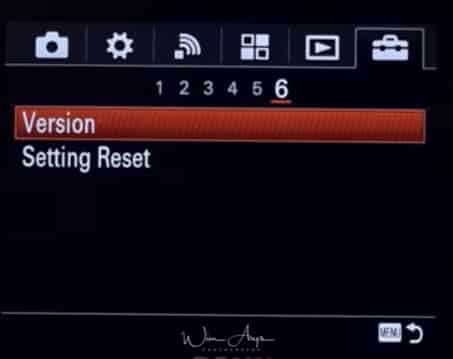
Version
Check what version of the operating system your camera and lens are running. Sony sporadically releases updates with new features, so it might be worth checking if any new firmware versions are available.
Setting Reset
Fully resets the camera to factory settings.
The Next Chapter is about the different Shooting Modes Available, another concept that is necessary to understand fully.
We’ll go over some of the more interesting features of the RX100 II. Let’s call it lazy mode for you out there that doesn’t want to browse through the entire menu system.
shooting modes available via the select button
Intelligent Auto:
This mode automatically detects the type of scene you’re shooting and adjusts the scene automatically. You’ll see the icon for the recognized scene appear on the top right hand of the screen.
These scenes are the same ones which can be selected individually in SCENE mode.
The Sony RX100 III will also use the most appropriate FOCUS AREA, and ISO value (the ISO range cannot be changed in iAuto though).
Drive Mode (single shooting, continuous shooting Lo-Mid-Hi), Self-timer and Self-timer cont (multiple images with the self-timer) can be changed by using the Fn button.
Works for both RAW and JPEG shooting.
Disadvantage: ISO range is fixed to 50-6400 (you can’t change the range).
Superior Auto:
Superior Auto is similar to iAuto, as it also detects scenes automatically, except it uses more complex processing.
This includes composite layering (layering different shots on top of each other for HDR style pictures) and automatically choosing what it thinks is the best image.
You can either choose whether you want the camera to save all images captured or just the composite image, by selecting S. Auto Img. Extract in the MENU system.
Disadvantage: ISO range is (like in iAuto) fixed and only useable for jpeg shooting.
P (Program Auto):
Program (P) mode automatically adjusts exposure and aperture according to your desired setting.
See this as a more advanced iAuto mode, as you’ll be able to change all other settings through the touch screen (Focus area, creative style, exposure compensation,…);
tip: lower the automatic ISO range to 100-1600 for better image quality (ISO-Auto range in MENU SYSTEM)
A (Aperture Priority):
Allows you to adjust the aperture and shoot, for example when you want to blur the background (large aperture like f/1.8), or want a sharp corner-to-corner image (around f/5.6-f/8).
The aperture value can be changed during movie recording, a technique that will be familiar to videographers.
Smaller F-value: The subject is in focus, but objects in front of and beyond the subject are blurred (what is called Bokeh).
Larger F-value: The subject and its foreground and background are all in focus.
If proper exposure cannot be set, the shutter speed on the shooting screen blinks.
S (Shutter Priority):
The go-to mode if you cant to shoot fast-moving subjects, by manually adjusting the shutter speed. You can express the movement of a moving subject in various ways by adjusting the shutter speed, for example, at the instant of the movement with a high-speed shutter, or as a trailing image with a low-speed shutter. The shutter speed can be changed while recording movies. The aperture is automatically adjusted to obtain proper exposure.
If proper exposure cannot be obtained, the aperture value on the shooting screen blinks.
- Use a tripod to prevent blurring when you use a slow shutter speed.
- The SteadyShot warning indicator does not appear in shutter speed priority mode.
- When the shutter speed is 1 second(s) or longer, noise reduction will be applied (Long Exposure noise reduction in the Menu ON/OFF) after shooting for the same amount of time that the shutter was open. This will temporarily freeze your camera, and you want to be able to capture images while noise reduction is in progress.
- The brightness of the image on the monitor may differ from the actual image being shot (there is no Live view on Sony cameras for long exposures).
M (Manual Exposure):
Both shutter speed and the aperture value can be changed in this mode, also during movie recording.
Press the bottom side of the control wheel to select the shutter speed or aperture value, then turn the control wheel to select a value.
When ISO Auto is used, the ISO value automatically changes to achieve the appropriate exposure using the aperture value and shutter speed you have set.
- If the aperture value and shutter speed you have set are not suitable for appropriate exposure, the ISO value indicator will blink.
- When the amount of ambient light exceeds the metering range of the Metered Manual, the Metered Manual indicator flashes.
- The SteadyShot warning indicator does not appear in manual exposure mode.
- The brightness of the image on the monitor may differ from the actual image being shot.
Bulb Mode in Manual exposure
Bulb is the mode used to shoot a trailing image of a subjects’ movement with a long exposure time. Think light trails from cars or fireworks.
- Press the bottom side of the control wheel to select the shutter speed, then turn the control wheel counterclockwise until BULB is indicated.
- Press the shutter button halfway down to adjust the focus.
- Press and hold the shutter button for the duration of the shooting.
- As long as the shutter button is pressed, the shutter remains open.
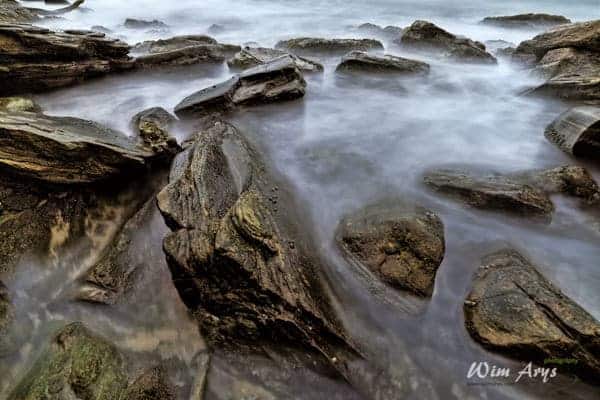
Tips:
- Use a tripod for long exposures.
- Use the PlayMemories remote or a wired remote control to eliminate any movement of the camera.
- After shooting, noise reduction will be applied (as noise builds up quickly with long exposures). This will take as long as your long exposure did, and you won’t be able to use the camera until this is finished.
Can’t get the shutter speed to Bulb Mode? Check these settings and turn them OFF:
- Is Smile Shutter activated?
- Is Auto HDR activated?
- Is Picture Effect is set to HDR Painting or Rich-tone Mono?
- Is Drive Mode set to Cont. Shooting, Cont. Bracket or Self-timer(Cont)?
Movie:
Although you can capture movies in any mode, it is easiest to change all related settings for movie recording here. You can adjust the shutter speed or aperture value to your desired settings for recording movies. You can also check the image angle before shooting.
Press the MOVIE button to start recording and again to stop recording
Menu:
- Program Auto: Allows you to shoot with the exposure (both the shutter speed and the aperture value) adjusted automatically. Other settings can be adjusted manually, and the settings are retained.
- Aperture Priority: Allows you to shoot after adjusting the aperture value manually.
- Shutter Priority: Allows you to shoot after adjusting the shutter speed manually.
- Manual Exposure: Allows you to shoot after adjusting the exposure (both the shutter speed and the aperture value) manually.
When a zoom lens is mounted, you can also zoom by operating that lens. When a motor zoom lens is mounted, move the zoom lever of the zoom lens to enlarge subjects.
Sweep Panorama:
Allows you to shoot a panoramic image by compositing the images.
- Panorama mode will capture a series of images in succession.
- You’ll be guided through this process using an arrow on-screen that shows the direction and speed of the camera panning.
- The RX100M3 will automatically detect and capture the series of images while panning.
- Afterward, it will stitch together all these images into a wide view of the scenery and save it as a Jpeg.
TIP: Panorama size (standard or wide) and panning direction can be changed in the MENU on page 1.
Scene Selection Mode (SCN)
Allows you to shoot with preset settings according to the scene. iAuto and Superior Auto detect these scenes automatically for you and applies the presets it deems best and does a very good job at that. However, in certain circumstances (when you know what you are going to capture) it is better to select the appropriate scene yourself, as it takes the guessing work out of the equation.
The Sony RX100 III has a decent range of well-designed presets:
Portrait:
Blurs background for a nice Bokeh, and sharpens the subject. How good this will look depends largely on the lens you’re using. A zoom is less suited to this kind of photography, best use a prime, fast lens.
This preset accentuates the skin tones softly.
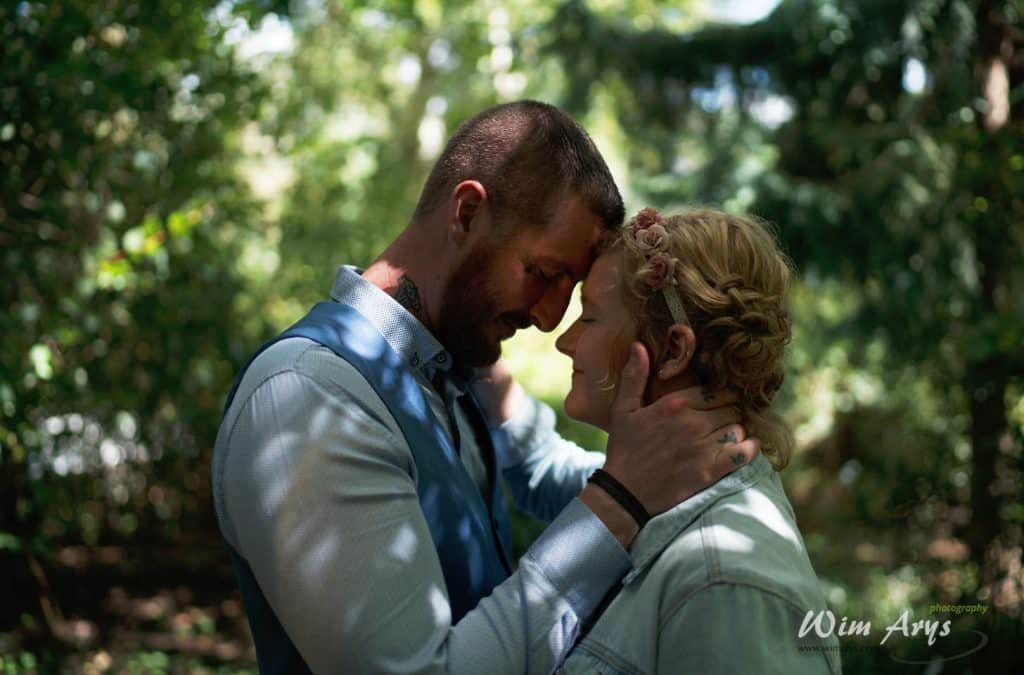
portrait SEL35F14Z at f/1.4
Sports Action:
Shoots a moving subject at a fast shutter speed (lso that the subject looks as if it is standing still. AF-C and continuous shooting hi is on, so you’ll be able to snap away while the shutter button is pressed.
Macro:
Shoots close-ups of the subjects, such as flowers, insects, food, or small items.
Landscape:
Shoots the entire range of scenery in sharp focus with vivid colors. The camera will go to a smaller aperture to achieve this, as lenses are sharper corner-to-corner at smaller apertures.
Sunset:
Shoots the red of the sunset beautifully.
Night Scene:
Shoots night scenes without losing the dark atmosphere. Will go to higher ISO values and larger apertures to achieve a useable shutter speed, enabling you to capture sharp images without blur. The Sony RX100 III does have its limitations when it comes to shooting dark scenery.
Hand-held Twilight:
Shoots night scenes with less noise and blur without using a tripod. A burst of shots are taken, and image processing is applied to reduce subject blur, camera shake, and noise. This does not work well in my opinion.
Night Portrait:
Shoots night scene portraits using the built-in flash.
Anti Motion Blur:
Shutter Priority mode, which will use the fastest shutter speed possible, to counter motion blur.
Best RX100 III for shooting portraits and make-up
Shooting portraits and makeup is a challenge for many photographers. Firstly we need to think about what we want to achieve. As a rule of thumb, the larger your aperture (the f number), the more separation between subject (focus point) and background you’ll have. If you’re going for maximum sharpness and detail, you can stop down the lens (change aperture) to around f/8. If you want to get that creamy ‘bokeh’ effect, shoot at the largest available aperture (f/1.8-f/2.8 depending on your focal length). Or set the SCN to Beauty.
Also, try out some of the Beauty processing presets on Beauty effects in MENU – playback options – page 2.
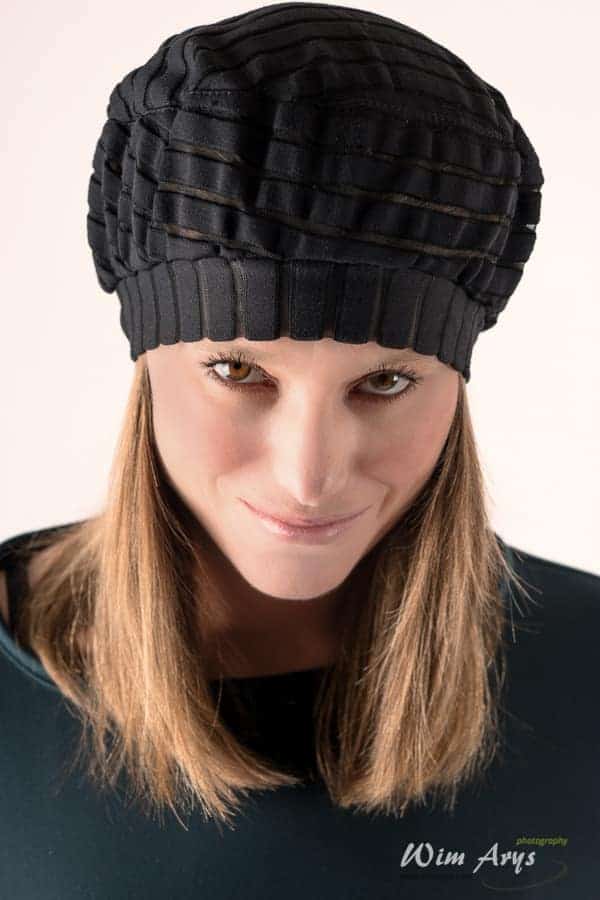
To get real looking colors, It’s a good idea to set your creative style ((MENU → Camera Settings → page 4) to standard and find a suitable white balance (also on page 4). Try the ‘Fluor’ settings if you are shooting under fluorescent light.
Other things you can consider are shooting in RAW so you have more control over white balance.
Buy a so-called gray card for even more precise colors using custom white balance in your camera.
Calibrate your monitor with something like Datacolour Spyder to make sure your monitor is displaying the colors as true as possible.
Mode dial functions: what’s the difference between intelligent and superior auto?
It might be a good idea to go over the differences between Intelligent Auto and Superior auto.
Intelligent Auto
- This mode lets the camera detect what kind of scene you are photographing. It switches to the scene setting it finds most appropriate, including aperture, shutter speed, ISO, and AF mode.
- These different scene settings are the same you’ll find manually selectable in SCN mode.
- All Sony cameras do a good job at detecting scenes, although the advanced photographer will prefer to shoot in Aperture, Shutter priority or fully manual mode in order to have more control over things like depth-of-field, movement, and focusing area.
Superior Auto
- Does the same scene recognition and (when the camera decides it is appropriate) adds hand-held twilight, anti-motion blur, and backlight correction HDR in order to optimize dynamic range, movement, and exposure.
- This is only for jpeg shooters, as it uses multiple images shot in close succession at high quality and combines them into one jpeg. Works well on stills but should not be used for movement.
Face Detection & Smile Shutter
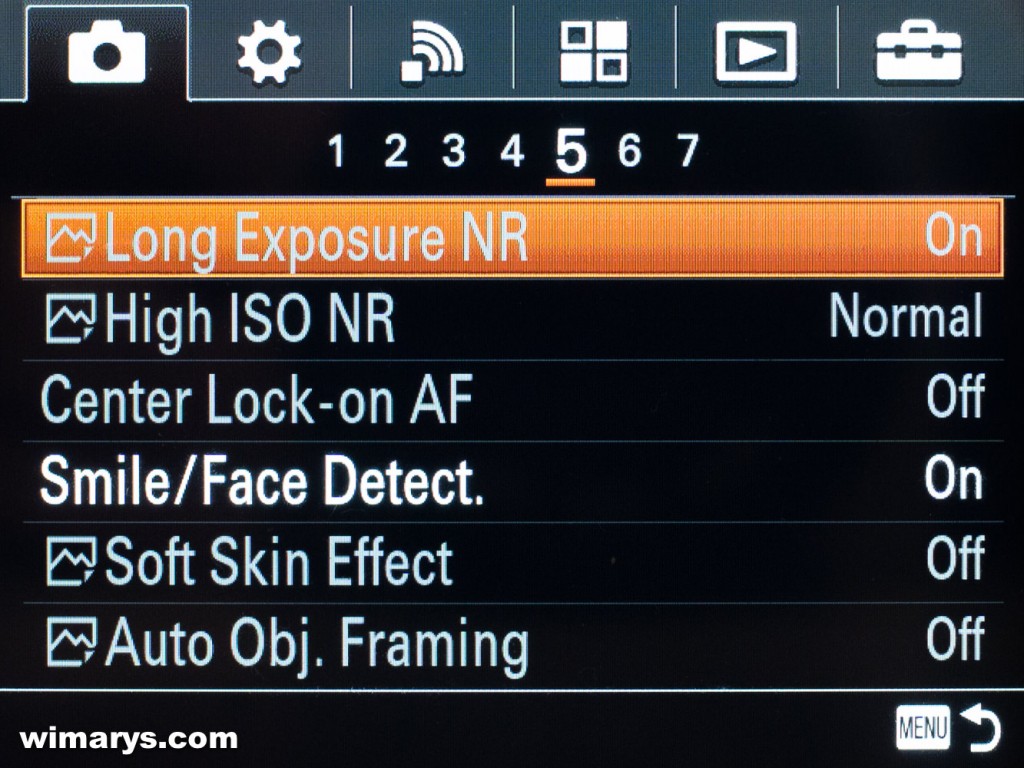
Face detection
- This is a valuable tool to increase AF accuracy and speed.
- There is a general face recognition setting, which uses the RX100 III’s processor to detect any faces and a face registration feature, where it will give focus priority to faces you’ve previously registered.
- There is also an option to record eight faces that will have priority when auto-focussing
Face registration with registered faces works in 2 steps:
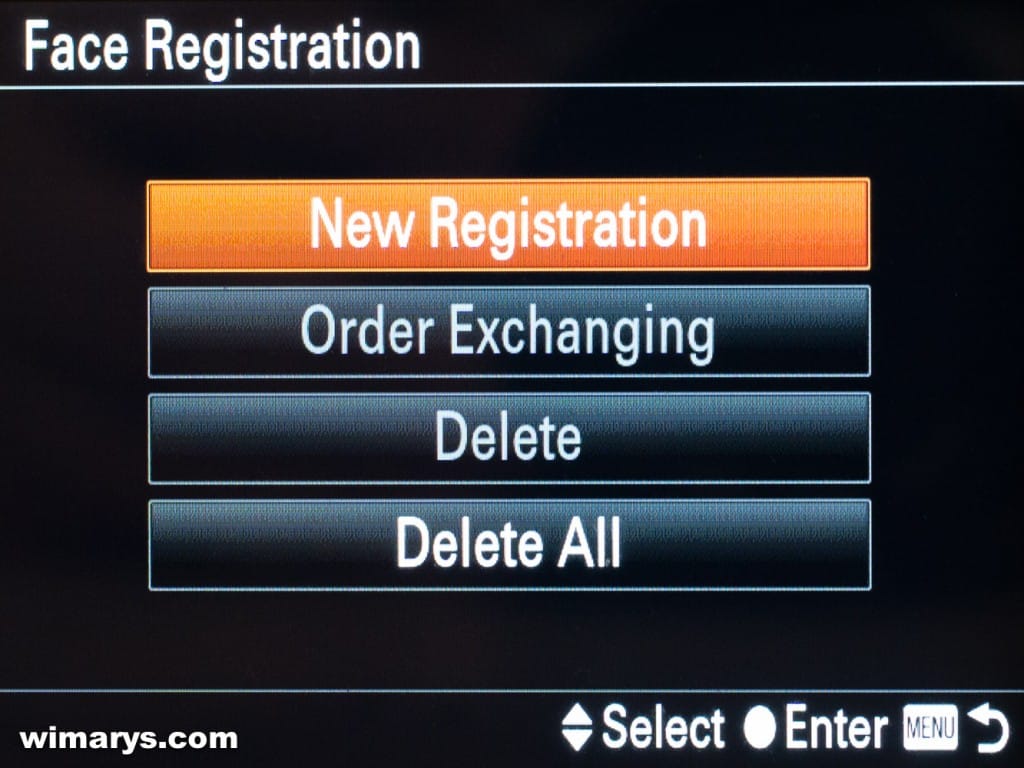
- first you’ll have to take a clear picture of the face through the face recognition menu,
- after your the new face has been registered, you can set an order of priority for the maximum of 8 registered faces
Smile Shutter
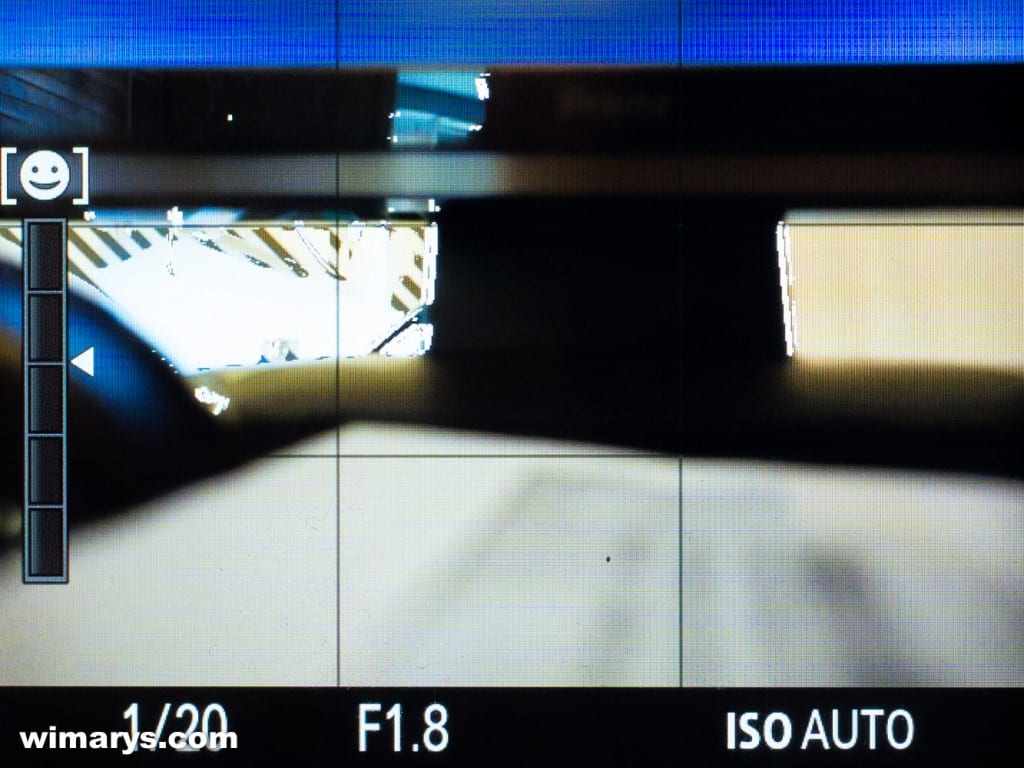
- Smile shutter will automatically take a picture once a smile is detected.
- Great for family or group shots.
- Big, Slight and Normal smile presets are available, and there is even a bar graph on the screen that shows the detection level.
Zebra highlight clipping aide

- Zebra will show zebra pattern lines on blown highlights.
- The clipping detection threshold is selectable from 70 to 100+. Lower values indicate possible highlight clipping sooner than higher.
- Setting it somewhere around 90 will give you a good indication of whether you’re in danger of unrecoverable clipping without having the screen cluttered with stripes all the time.
Center Lock-on AF

- When you press the center button, the camera detects the subject positioned in the center of the screen and continues to track the subject.
- Align your subject in the center of the frame and press the center of the control wheel.
- Press again to stop tracking.
Exposure aides
AE lock
- When contrast between the subject and background is high, meter the light at a spot where the subject appears to have the appropriate brightness and shut the exposure before shooting.
- You’ll need to assign a button to this function to do this in Menu – Custom Settings – Custom Key Setting and then assign the AEL toggle to the desired key.
Then:
- Center the spot at which the exposure is to your liking
- Press the button to which the AEL toggle function is assigned
- exposure will be locked, and AE lock lights up.
- Focus on your subject and press the shutter button.
- To cancel the exposure lock, press the button to which the AEL toggle function is assigned.
It’s easiest to select the AEL hold function in Custom Key Settings; then you can lock the exposure as long as
you are holding down the AEL button.
ND Filter and Bulb mode
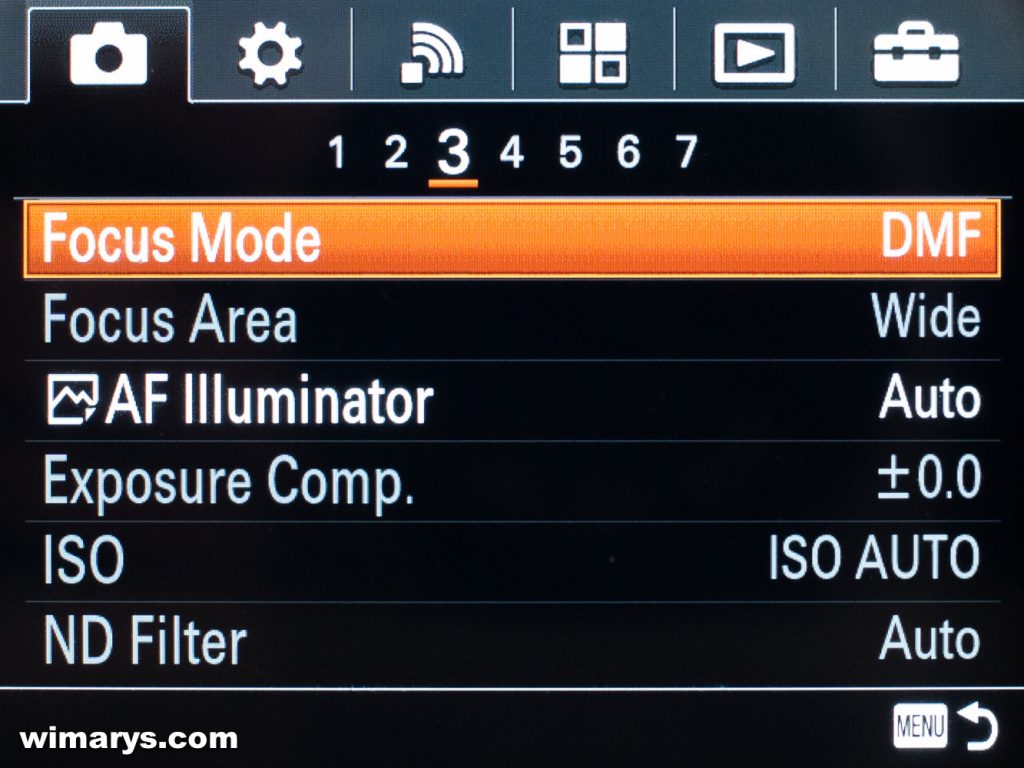
ND Filter
- The RX100 III has 3 EV steps ND filter. This is sufficient to enable you to get that smooth waterfall or flowing river picture.
- You can easily access it through the Fn button Menu.
Bulb Mode
Bulb mode is great for shooting trails of light, such as fireworks, car lights, etc.
It’s best to use a remote or the Sony Playmemories remote app (that is downloadable for free) as you want to eliminate movement.
- Firstly set the mode dial to M.
- Connect your phone to the camera using Wifi or NFC.
- Then:
- Dial exposure time to Bulb on the app.
- Dial in a suitable Aperture value from F/5.6.
- Press the shutter button on the app to start the exposure.
- Press the shutter button again on the app to stop the exposure.
Conclusion
Besides excellent image quality for a pocket camera, many of the advanced functionality of the A6000 and A7 range have been incorporated in this little beast. The Sony RX100 III is packed full of interesting functions for you to discover, making it a very useful pocket camera.


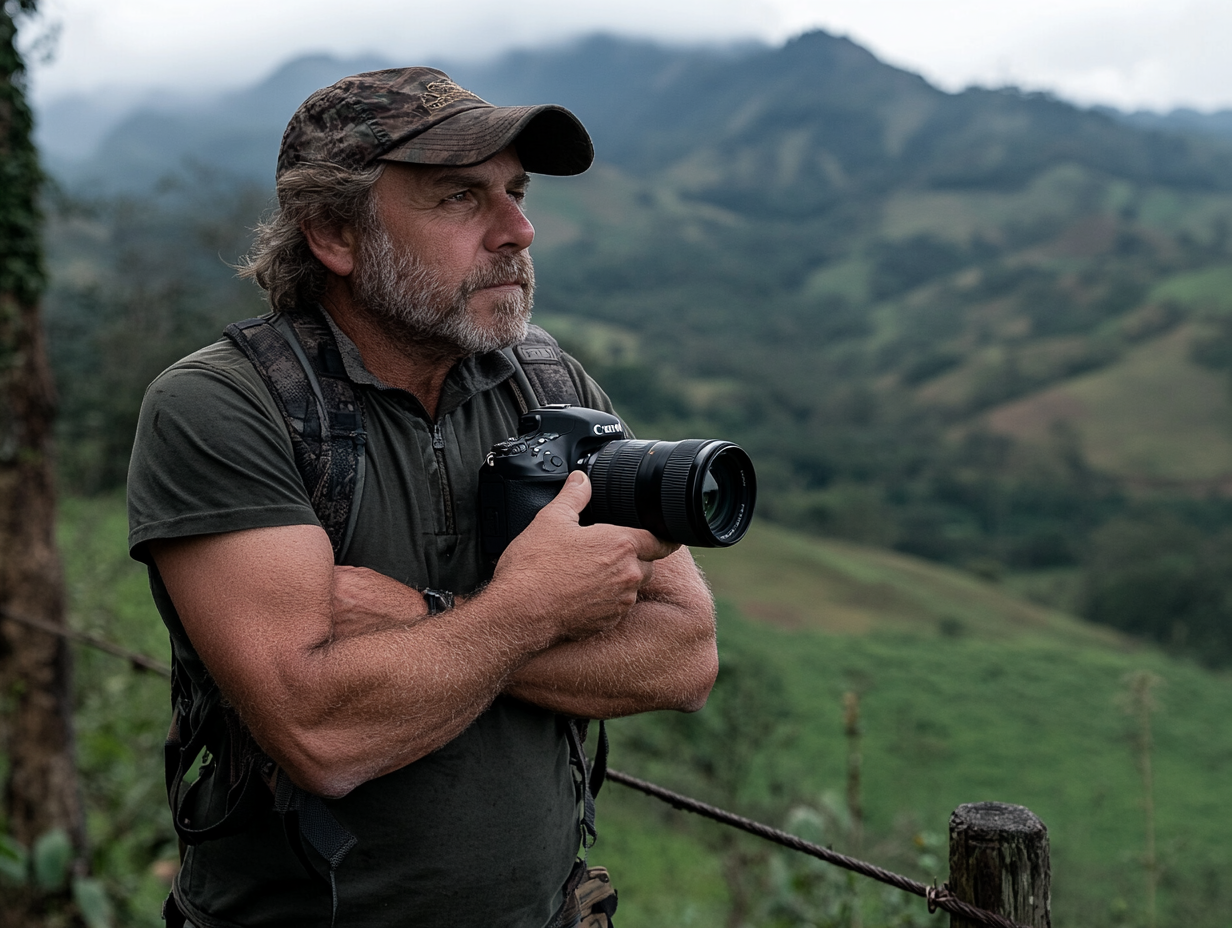
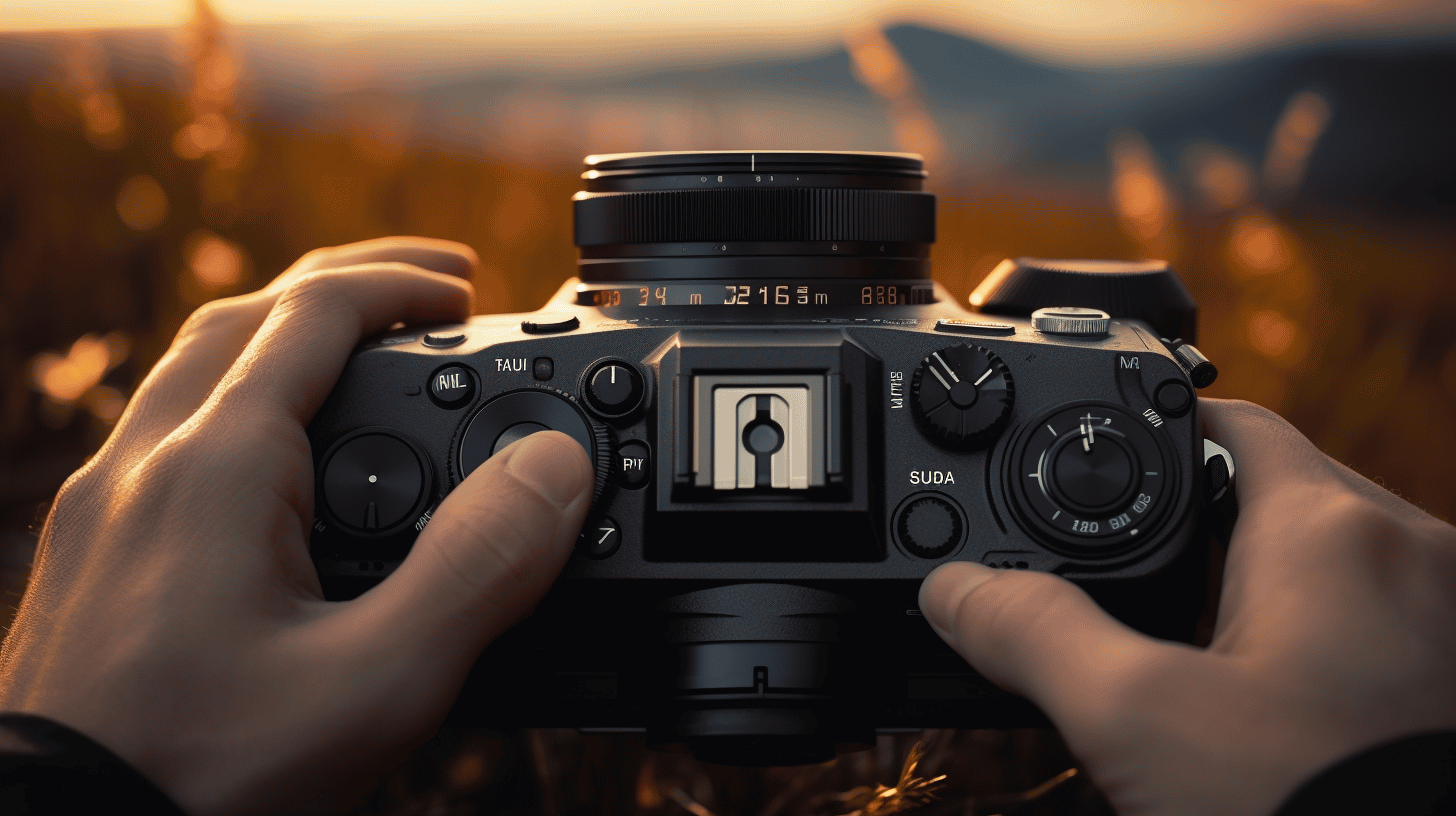
A very comprehensive review, nice!
Hi Wim,
a fellow belgian photographer wants to figure out how to actually get the bulb mode to work with the play memories app the way you’ve described above. I only can shoot at 30 secs the most. The start/stop function doesnt really work on the app.
And i want to take australian night sky pics!
alll the best and thanks
Yannick
Hi Yannick, hace you tried going beyond 30 seconds in manual mode on the camera itself? And then using the play memories remote app as a remote shutter?
Hey Wim,
Thanks for your quick reply. Yes I have. First I had problems trying to figure out why BULB mode didn’t work, even with your two tips. I think you should add: “it will only work in single mode shooting, not in Continous Mode”. It took me 2 weeks to figure that out, had to do a system reset.
Then I’ve connected the app to play memories, but it doesnt show me the BULB option no more. I cant figure out why. Face detection off, HDR off, single mode. But I cant select it.
Thanks a lot!
I have the same problem!
Great advises. Thanks.
How and when “BULB MODE” is available?
Thanks in advance.
Hi Daniel,
Set the mode dial to M (Manual Exposure)
Press down on the control wheel to select shutter speed and turn the control wheel counterclockwise until [BULB] is indicated.
Press the shutter button halfway down to adjust the focus.
Press and hold the shutter button for the duration of the shooting. As long as the shutter button is pressed, the shutter remains open.
Easiest way to avoid camera shake is to use a tripod and a Sony remote.
Good luck!
nice document, will try out the settings, also activate zebra, and start shooting in M mode, as the auto modes tend to overexpose pictures, as I noticed during my holiday in the south of France and recently A’dam. Pity that the camera uses a lot of battery power, especially when using the viewfinder….
Hi Bart, yes it’s a common complaint. Try turning on airplane mode to save at least some battery life. Best, Wim
Like all the tips, thanks . I do want to know if I can take still images while recording, or is there a way extracting still images from the video on the camera.
Hi Eliza, some more expensive Sony cameras have this feature, but it is not possible with the RX100 III. Best, WIm
Hi great review thanks. I just bought my RX100 a few weeks ago so I’m still discovering all it can do. One thing puzzles me though: why is the red eye reduction flash setting hidden within the menu options? Why isn’t it available when you press the dedicated flash button? Seems odd.
Hi Lesley, If you turn it ON in the Menu, it will be on when you use your flash. That is the most important thing, no? Best, Wim
Hi Wim – just bought the mk iii. when I transfer a video taken on auto+ it wont transfer but photo transfer is fine – is this normal ?
Thanks – Garry.
Hi Garry, totally normal. A limitation of the system. Best, Wim
mmm… strange but ok – thankyou for the reply.
Is it possible to trigger studio flash with the RX100 iii what with it having no hotshoe
Hi Matthew, in theory you could trigger studio flashes optically with the pop up flash. But since the RX100 use a pre-flash (for metering purposes) your studio flashes would probably optically trigger on these.
Hi I brought the RX100 iii to replace my A77 as I got fed up of lugging it round when out & about with our Grandson. I am now looking at doing some studio work again & was wondering if there is a way to trigger studio flash what with the RX100 iii having no hotshoe
Hi I brought the RX100 iii to replace my A77 as I got fed up of lugging it round when out & about with our Grandson. I am now looking at doing some studio work again & was wondering if there is a way to trigger studio flash what with the RX100 iii having no hotshoe
Is it possible to trigger studio flash with the RX100 iii what with having no hotshoe
1) Make the studio flash behave as an optical ‘slave’ that is triggered by the pop-up flash.
2) Use flash exposure compensation on the rx100 to set pop up flash level as low as possible, while still triggering the studio flash
3) If you do not like the extra catch lights caused by the pop up flash, flip the pop-up flash to its light does not hit the subject
Hi Wim,
Thanks for the article, does the MK3 have the ability to name files using yyyyMMMDD_… or is there an App that could be loaded?
It does not Peter.
Hi Wim,
Thanks for the insight on this cam. Do you know if it us possible to set the cam, so that after switching off all the photo setup (like ISO, ND, EV, AF…) are reset? I keep forgetting to reset all of them for a new scenery and end up with bad pictures, which sometimes I don’t see rightaway on the little display…
Thx
Piet
Hi Piet, sure! You need to go to the last page of the last menu called the setup menu for this. Simple go to “Setting Reset” and reset your camera. Best, Wim
Hi Wim, We purchased the Sony RX100 III for my wife to use but through all the your detailed info we seem to have a much better camera that we initially thought we had. My Sony Nex 6 is just starting to have issues with focusing most of the time I end up detaching the lens (or all 4 lenses) and so on till it decides to work properly, when it does work it still takes great images.i am not sure on what to do – do i just carry on with the RX or should I upgrade the NEX 6 to what I am not sure at this stage – your thoughts would be much appreciated Cheers Glenn from NZ
Hi Glenn, that is always a difficult decision and a tough question to answer. Sure an APS-C camera will get you better image quality then an RX100, but if you don’t print them large or want to manipulate them to a large degree in an image editor, and if you’re happy with the results, why not stick with the RX100? You can always spend the money in the future if at one point you decide you need it.
Hi Wim Thanks for your reply. I am still using the Nex 6 can’t seem to let it go, could you please explain to me how to freeze water ar take good pics using long exposure with the nex 6 as for some reason I just can’t get it right and my photos suck. Cheers glenn
Hi Glenn, can’t really help you with the NEX 6 as I don’t have any experience with that camera.
Dear Wim Arys
Thank you for a very useful guideline to RX100M3. I have found your text clear and easy to follow when operating my new camera.
Best wishes
NK
Thanks Nasir
Thanks a lot for this, you should work for Sony(they don’t know how to write a manual)…
Nicely written user guide, thank you! Are you aware of a way to save the RX100 M3 settings to a SD card? I read your info on Memory Recall x3 but I’m thinking about a catastrophe where you have to re-do ALL your settings, like you get your camera returned from repair. If not, what is your recommended strategy to record all your settings? On paper with Main Settings plus 3 sets of MR settings seems very painful. Love the camera BTW—it thinks it is a DSLR!
Hi Jerol,
I believe this model does not have that feature unfortunately.
Thank you Wim, it is really a helpful guide. My question is very basic, I am just starting with photography and video making…
When selecting the file format with the camera, what do you mean exactly by using the “compatible devices”? Are you referring to the memory card, the editing ? Best Fifi